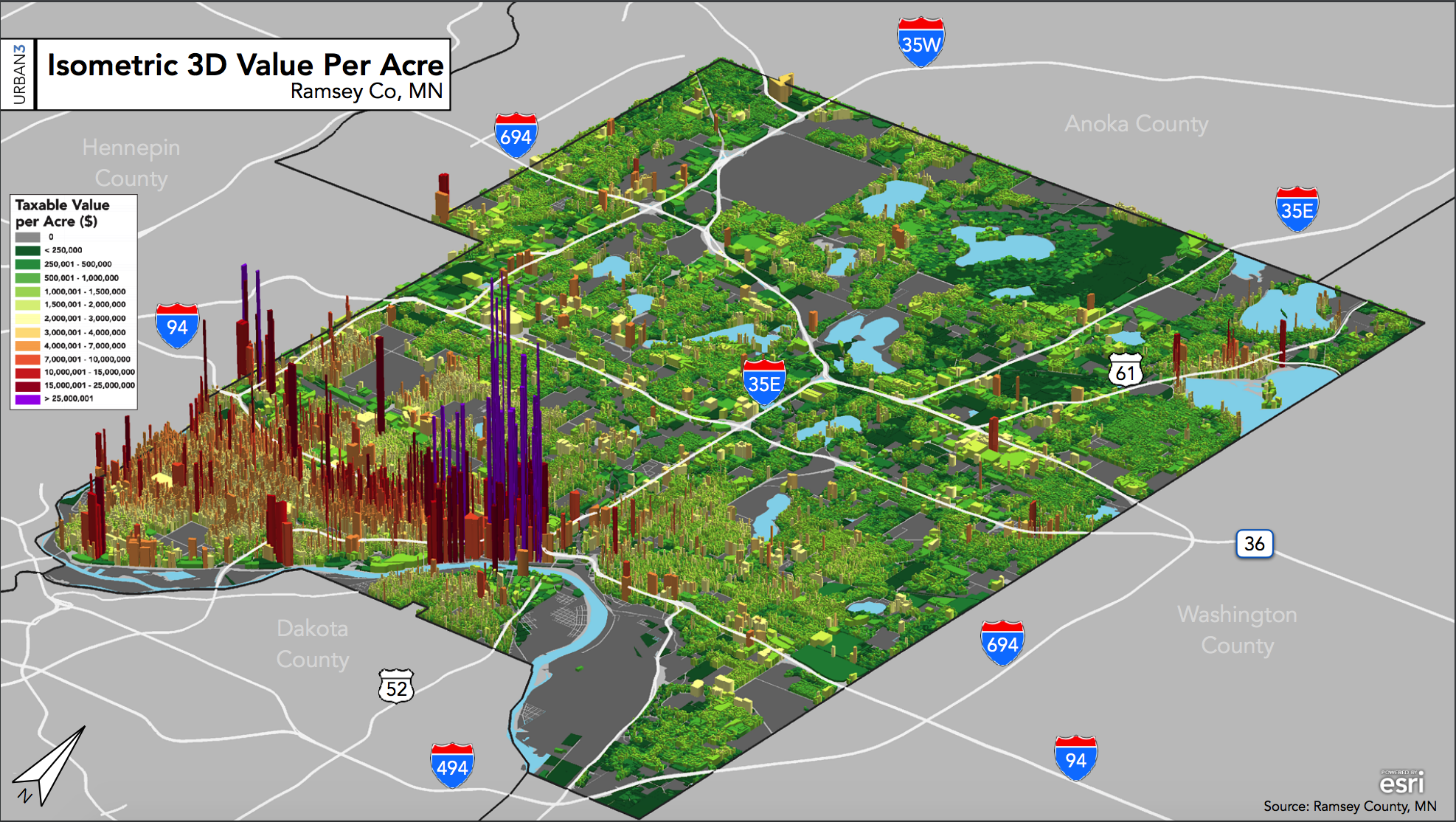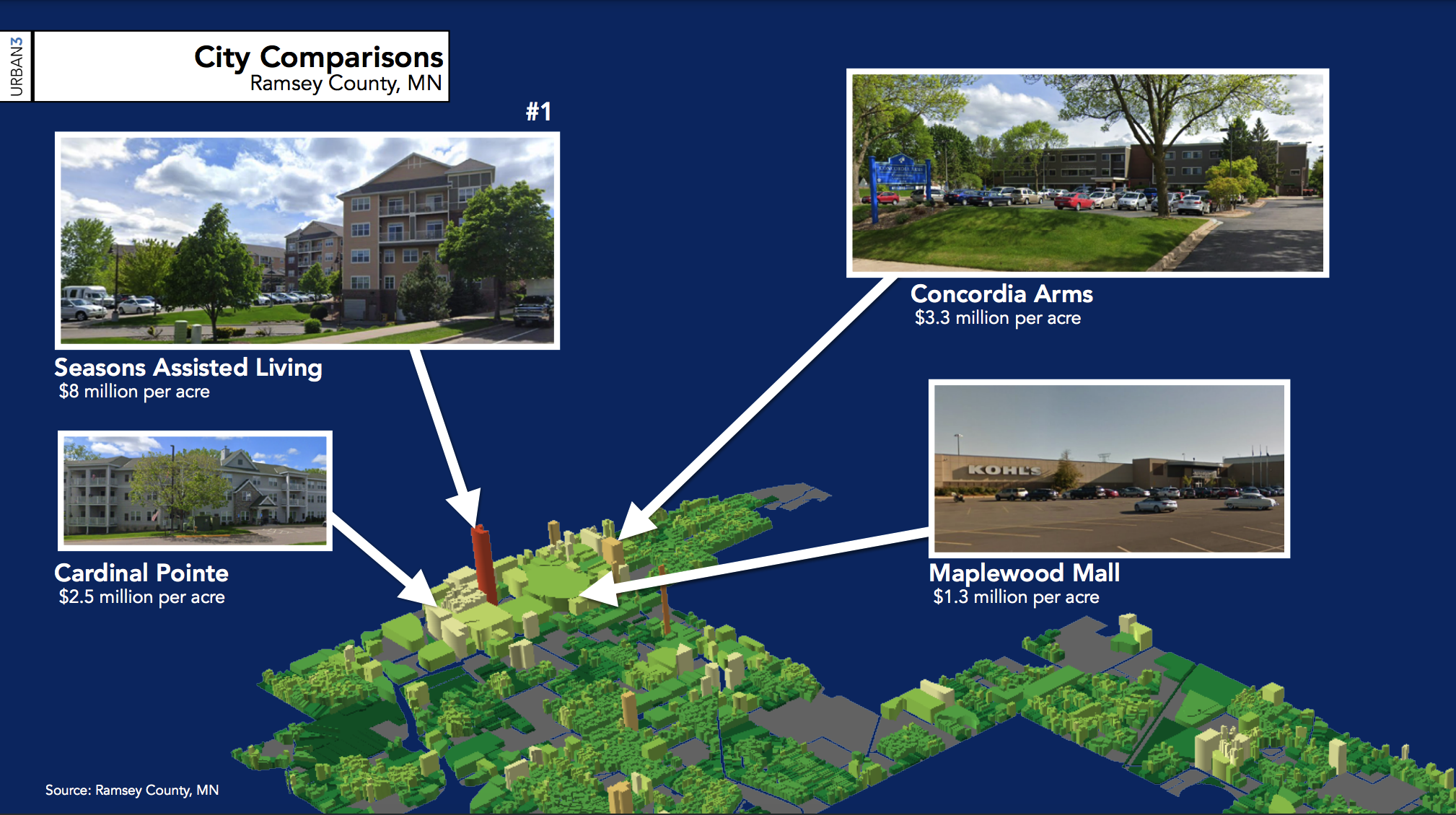The Question Every City Should Be Asking
The geoanalytics firm Urban3 is known for its striking 3D value per acre models; cities across the United States have hired them to take a data-driven, spatial look at their finances. Urban3 began using the value per acre model when they realized it was the best way to talk about what areas in a city are most productive for the space they take up. Cities and counties at their basic level are finite areas of land, so it is logical to look at land use’s effects on the city’s coffers.
Using value per acre normalizes revenues and tax values so that it is possible to make an easy-to-understand, apples-to-apples comparison of areas in a city or county. Check out a more in-depth description of value per acre analysis here.
One theme can quickly be identified when looking at Urban3’s work from project to project: the way we built places before the 1940s was much more productive than the manner of development in the decades that followed. This is shown in the models created by Urban3, which illustrate spikes of economic productivity in the historic downtown areas of any county or city. These spikes are surrounded by development that generally decreases in productivity further from the city center, as you move out toward the more modern suburban development.
In Ramsey County, Minnesota (shown above), Urban3 found this pattern at play. The county’s oldest, most compact, and most populous city, St. Paul, is clearly Ramsey’s most financially productive place. Throughout the rest of the county, you will find more spread-out, low-value suburban cities with no discernible downtown.
Even though there aren’t a lot of hyper-productive developments throughout Ramsey, there are some interesting spikes worth investigating. What kind of development should the county be encouraging to see a financially sustainable future?
This graphic illustrates how typically, the larger the building, the lower the value per acre. It emphasizes the importance of thinking about growth critically; is that expansive superstore really making the best use of the space? We can see these very small buildings, like Mischief Toy Store, are producing a huge value per acre while taking up few resources. On the other side, we have large buildings, like Target, producing a very small value per acre while using a lot of public resources. If we focused on building more of the small-scale developments, our cities would be making much better use of their resources.
Let’s have a look at some specific examples from cities around Ramsey County, starting with Maplewood, Minnesota, a city of about 38,000 residents.
Maplewood is the sort of low-density suburban city that is common across the United States. The average value per acre in Maplewood is $435,000. By comparison, the average in the historic city of St. Paul is $1,630,000. In the graphic below, we can see the most productive buildings in the city—note that the assisted living facility is 8 times more valuable per acre than the Maplewood mall.
Looking at these different development typologies, notice that the highest productivity developments do not have to be 20-story skyscrapers. Making the best use of land does not necessarily mean you have to build up every neighborhood to the highest density possible. Simply building four-story residential buildings, clustered around a center of economic activity, for example, could make a huge positive change for a city’s revenue. We can see how much taller the spikes of tax productivity are in areas with multi-story housing and active commercial centers, compared to the green single-family, exclusively residential zones, which barely register on the 3D map.
Let’s compare Maplewood to another city in Ramsey County: White Bear Lake, a slightly smaller city with a population of 26,000. White Bear Lake has an average value per acre of $640,000, noticeably higher than Maplewood.
Taking a look at the 3D model of White Bear Lake we see a similar image, but it is clear where the more historic, denser buildings are located. The most valuable building per acre in White Bear Lake is the Washington Square building, which is 12 times more productive than the Target we saw in Maplewood.
White Bear Lake clearly shows us the power of historic downtown buildings. No matter how small the downtown may be, it tends to be vastly more productive over the long term than any spread-out, suburban big-box development. Because White Bear Lake has prioritized preserving its downtown core, we generally see higher values per acre here than in Maplewood, which did not prioritize keeping its central district alive.
The value per acre metric is essential to apply in any city if you want to understand where the most financially productive developments are located. It shows us what kind of developments a city or county should be encouraging and what kind they should be avoiding. It is clear from the models that the pre-1940s urban fabric is incredibly productive and financially sustainable, and should be maintained and replicated wherever it is feasible. This is not to say you need to simply subsidize density at any cost, but that future development should be thought about more critically. Every city should be asking the question, “Is this really the best use of our finite resources?”








What do a taqueria, a bike shop, and an art center have in common? They’re all outpacing a retail giant when it comes to property tax revenues.